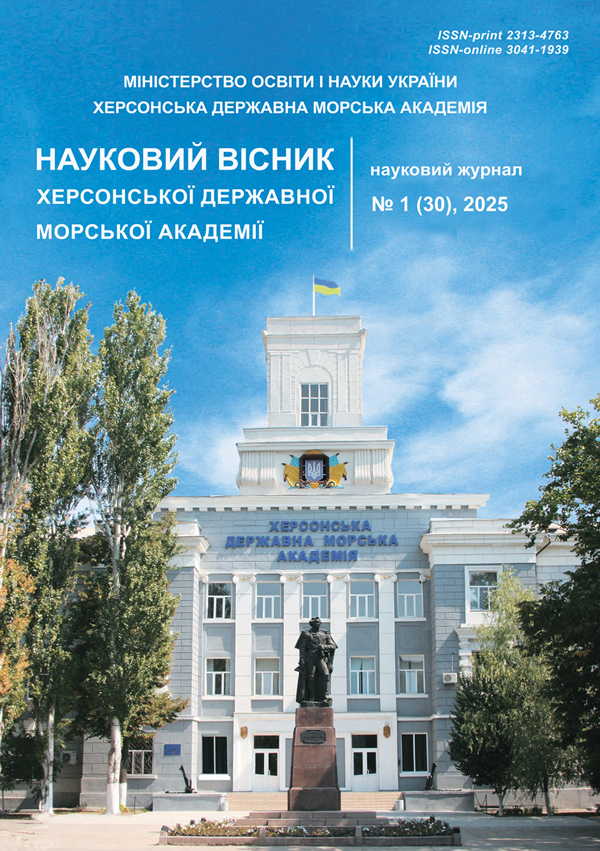THEORETICAL MODELS OF APPROXIMATION OF WAVE CORRECTIONS IN UNDER KEEL CLEARANCE CALCULATIONS
https://doi.org/10.33815/2313-4763.2025.1.30.222-236
Abstract
Year after year, maritime transportation continues to grow, with an increasing count of ships and their displacement requiring enhanced navigational skills and precision. Weather factors such as wind and waves significantly influence a vessel's ability to maintain position and accurately determine safe depths, making them critical for safe navigation.
This article aims to derive analytical dependencies for the Swell parameter based on vessel length and wave height within the most common operational ranges for ships. It also provides tabulated Swell values and a software product designed for cadet training alongside the NaviSailor 4000 simulator. The article analyzed existing accounting methods for wave-induced increases in vessel clearance. It was found that no proposed method provides practical recommendations for calculating the Swell parameter for any ship length or wave height. Although tables containing the desired parameter exist, additional interpolation calculations are required to determine the Swell value. To address this, preliminary calculations were performed using interpolation of known values for this parameter. Then, ensuring maximum alignment with reference data, mathematical models were developed for each 10-meter increment in vessel length and each 0.5-meter increment in wave height. Through extrapolation, with constraints on wave amplitude values, specific Swell parameter values were determined by tabulating functions. The resulting table of Swell values allows for direct application without the need for prior interpolation calculations. Based on these models, the WaveCheckRoute software was developed. This tool enables users to work with weather maps in .grib format for any forecast step, overlay routes in .rt3 format, select vessel schedules, and analyze dangerous wave heights along a route at estimated arrival times. The analysis is conducted based on weather forecast intervals and vessel speed, enhancing passage planning and safety in maritime navigation.
References
2. Petrovskyi, A. V., Isaychev, A. G., Zlobin, Y. O. (2023). On the issue of adjustment and calculation of navigation depth parameters during route creating. Priazovskyi State Technical University. Section: Technical sciences. Volume 47, pp. 324–335. https://doi.org/10.31498/2225-6733.47.2023.300119.
3. Vahushchenko, L. L. (2016). Sudnovi naviatsiino-informatsiini systemy. Odesa, NU «OMA». 238 p.
4. Bowditch, N. (2019). American practical navigator an epitome of navigation; Publisher: National geospatial-intelligence agency Springfield, Virginia, USA, Volume 1, p. 753 URL: https://thenauticalalmanac.com/2019_Bowditch-_American_Practical_Navigator/Volume-_1/2019 %20 Bowditch_Vol_1_LoRes.pdf (дата звернення 11.01.2025).
5. Cartwright, B. K., Melchers, R. E., Renilson, M. (2024). Modelling Sea-Surface Wave Motion and Ship Response Using Smoothed Particle Hydrodynamics and Finite Element Analysis. J. Mar. Sci. Eng. 2024, 12, 1919. https://doi.org/10.3390/jmse12111919.
6. Seakeeping ship behaviour in rough weather: By A.R.J.M. Lloyd. Ellis Horwood, Chichester, 1989. p. 486.
7. Recommended practice: Environmental conditions and environmental loads. DNV-RP-C205. August 2017 ed.:, Publisher: DNV GL AS, Det Norske Veritas group, p. 259. URL: https://fenix.tecnico.ulisboa.pt/downloadFile/1689468335664874/DNVGL-RP-C205_2017-Environ ment.pdf (дата звернення 11.01.2025).
8. Burenkov, O., Pipchenko, O., Aleksishin, A. (2020). PRACTICAL FEATURES OF ECDIS SAFETY DEPTH CALCULATION. Shipping & Navigation, pp. 16–26. https://doi.org/10.31653/2306-5761.30.2020.16–26.
9. ECDIS Procedures Guide, 2018 ed.; Publisher: Witherby Publishing Group Ltd, Scotland, UK, p. 176.
10. Independent investigation into the grounding of the Panamanian registered bulk carrier Pasha Bulker on Nobbys Beach, Newcastle, New South Wales, on 8 June 2007. The Australian Transport Safety Bureau.
URL: https://www.atsb.gov.au/sites/default/files/media/1362985/mair243_001.pdf (дата звернення 11.01.2025).
11. Gourlay, T. P. (2007). Ship under-keel clearance in waves. Proc. Coasts and Ports, Melbourne, pp. 1–6, URL: https://cmst.curtin.edu.au/wp-content/uploads/sites/4/2016/05/gourlay-2007-ship_underkeel_clearance_in_waves.pdf (дата звернення 11.01.2025).
12. Gallucci, F., Vernengo, G. (2023). Impact of direct seakeeping computation on ship Underwater Keel Clearance prediction. 12th International workshop on ship and marine hydrodynamics (IWSH-2023), IOP Conference Series: Materials Science and Engineering, Volume 1288, Aalto University, Espoo, Finland, 28/08/2023, pp. 1–10. https://doi.org/10.1088/1757-899X/1288/1/012031.
13. MSC.1/Circ.1228. Revised guidance to the master for avoiding dangerous situations in adverse weather and sea conditions; Publisher: IMO, London, 11 January 2007, pp. 100–107. URL: https://www.piclub.or.jp/wp-content/uploads/2019/04/Loss-Prevention-Bulletin-Vol.45-Light_6.pdf (дата звернення 11.01.2025).
14. Lee, S. W., Sasa, К., Masagaki, T., Chen, С. (2024). Effects of swell waves caused by atmospheric depression on ships sailing in the North Pacific ocean. Ocean Engineering, Volume 312, Part 2, https://doi.org/10.1016/j.oceaneng.2024.119121.
15. MSC circ. (2017). 1503 ECDIS – Guidance for Good Practice. IMO, Publisher: Albert Embankment, LONDON, p. 23. URL: https://iho.int/uploads/user/About%20IHO/International_ Organisations/ECDIS-ENC/English/MSC.1-Circ.1503-Rev.1%20-%20Ecdis%20-%20Guidance% 20 %20Good%20Practice.pdf (дата звернення 11.01.2025).
16. Recommendations for the Organization of the Navigation Service on Marine Vessels of Ukraine (RNSMV-98), South Research Institute of Marine Fleet, Odesa, 1990, с. 59.
17. zyGrib – GRIB File Viewer. Weather data visualization. URL: https://www.zygrib.org.
18. IHO TRANSFER STANDARD for DIGITAL HYDROGRAPHIC DATA, 3.1 ed. (2000-2014), Special Publication No. 57, Publisher: International Hydrographic Bureau, MONACO, 2014, p. 3-B-8. URL: https://iho.int/uploads/user/pubs/standards/s-57/31Main.pdf (дата звернення 11.01.2025).
19. Manual on Codes, International Codes, Annex II to the WMO Technical Regulations Part B – Binary Codes, Part C – Common Features to Binary and Alphanumeric Codes. 2023 ed.; Publisher: WMO, Geneva, 2023, Volume I. 2, No. 306, p. 1407. URL: https://library.wmo.int/records/item/35625-manual-on-codes-volume-i-2-international-codes? language_id=13&back=&offset= (дата звернення 11.01.2025).
20. Voloshynov, S., Petrovskyi, A., Popova, H., Cherniavskyi, V., Pindosova, T. (2021). Use of VR Technologies in the System of Quality Assessment of Seafarer’s Professional Competence Formation. Workshops. ICTERI 2021: Communications in Computer and Information Science., Publisher: Springer, Cham, Volume 1635., pp. 258–280, https://doi.org/10.1007/978-3-031-14841-5_17.
21. Zinchenko, S. M., Nosov, P. S., Mateychuk, V. M., Mamenko, P. P., Grosheva, O. O. (2019). Automatic collision avoidance with multiple targets, including maneuvering ones. Radio Electronics, Computer Science, Control, No.4, pp. 211–222. https://doi.org/10.15588/1607-3274-2019-4-20.






